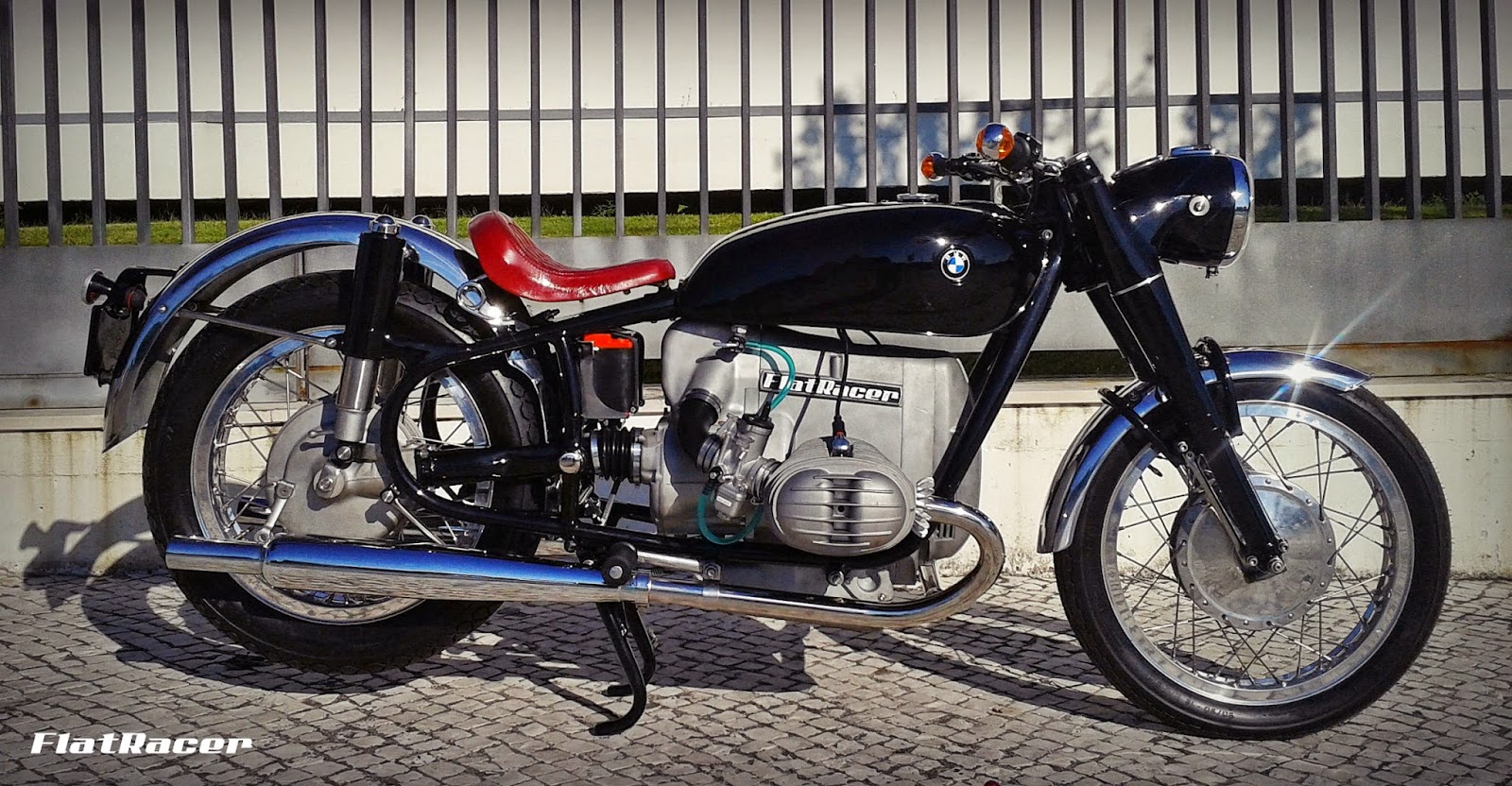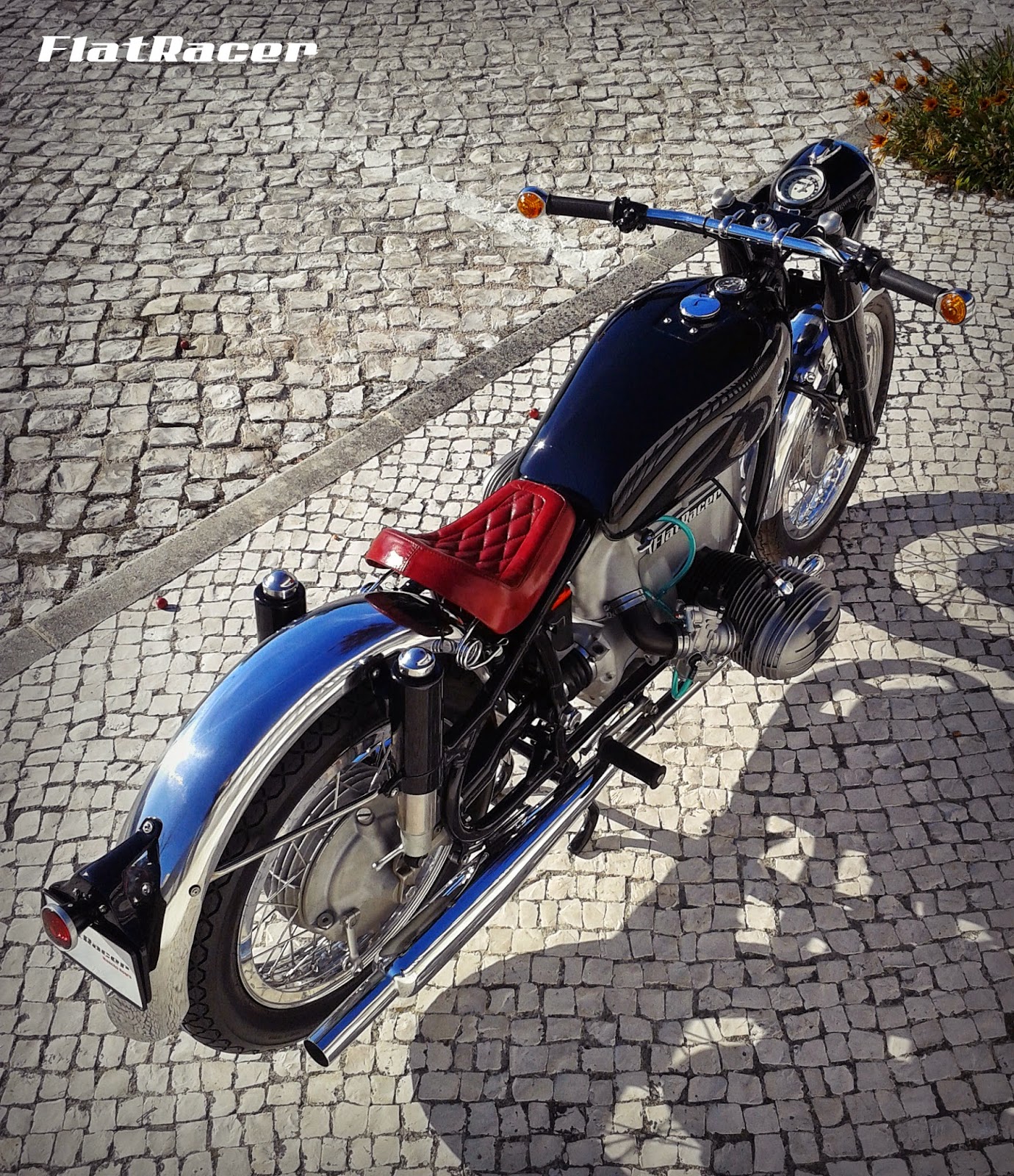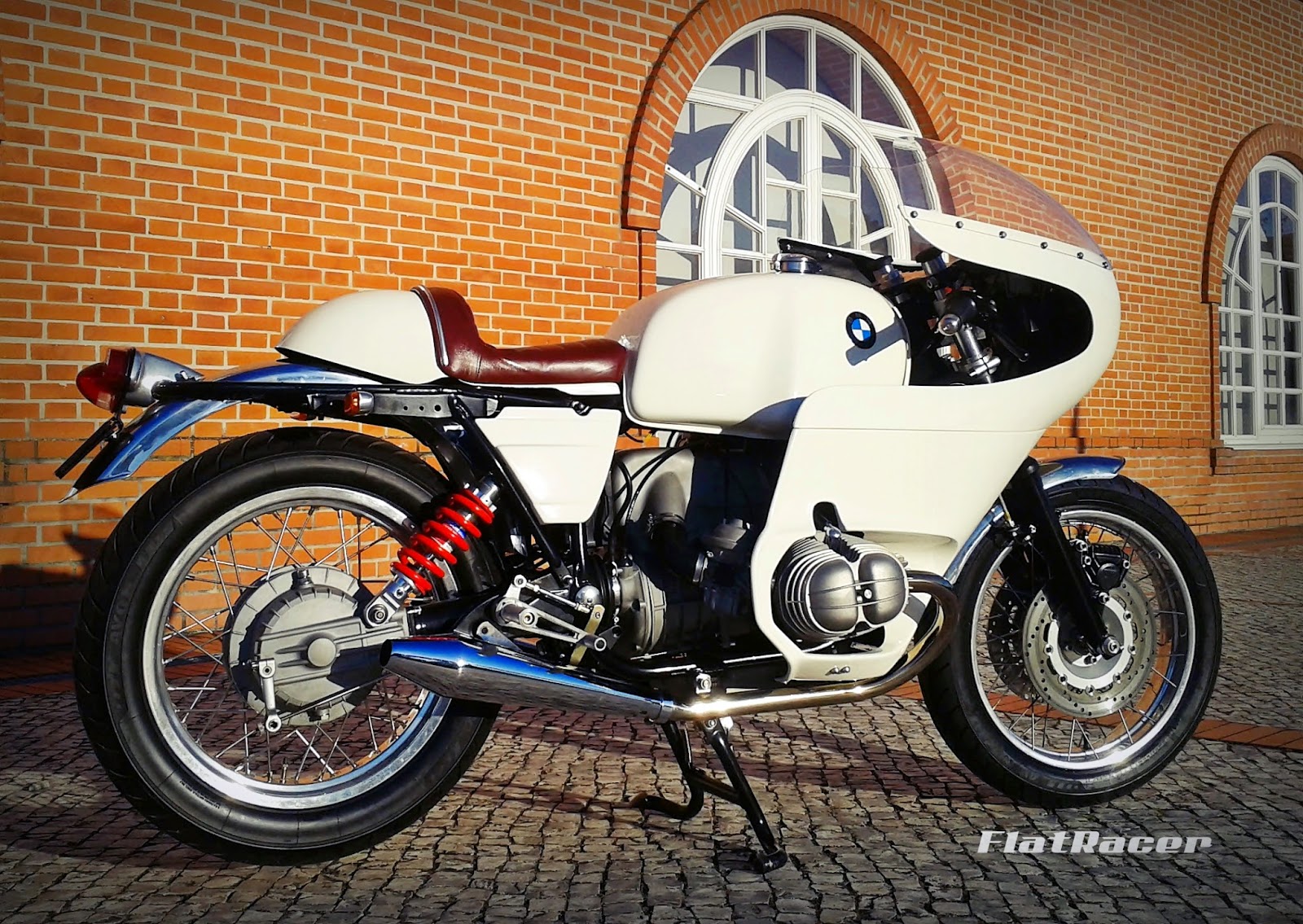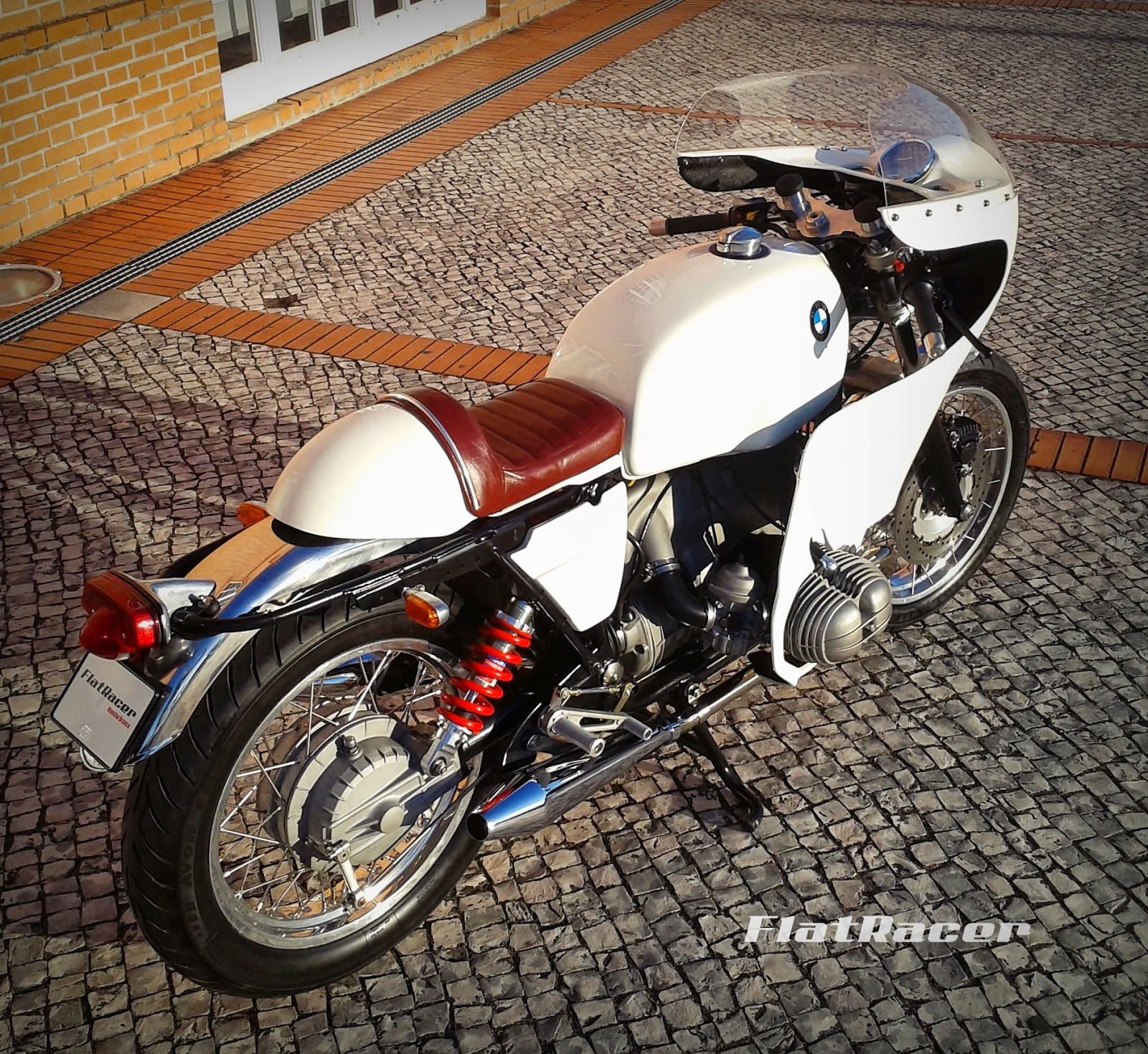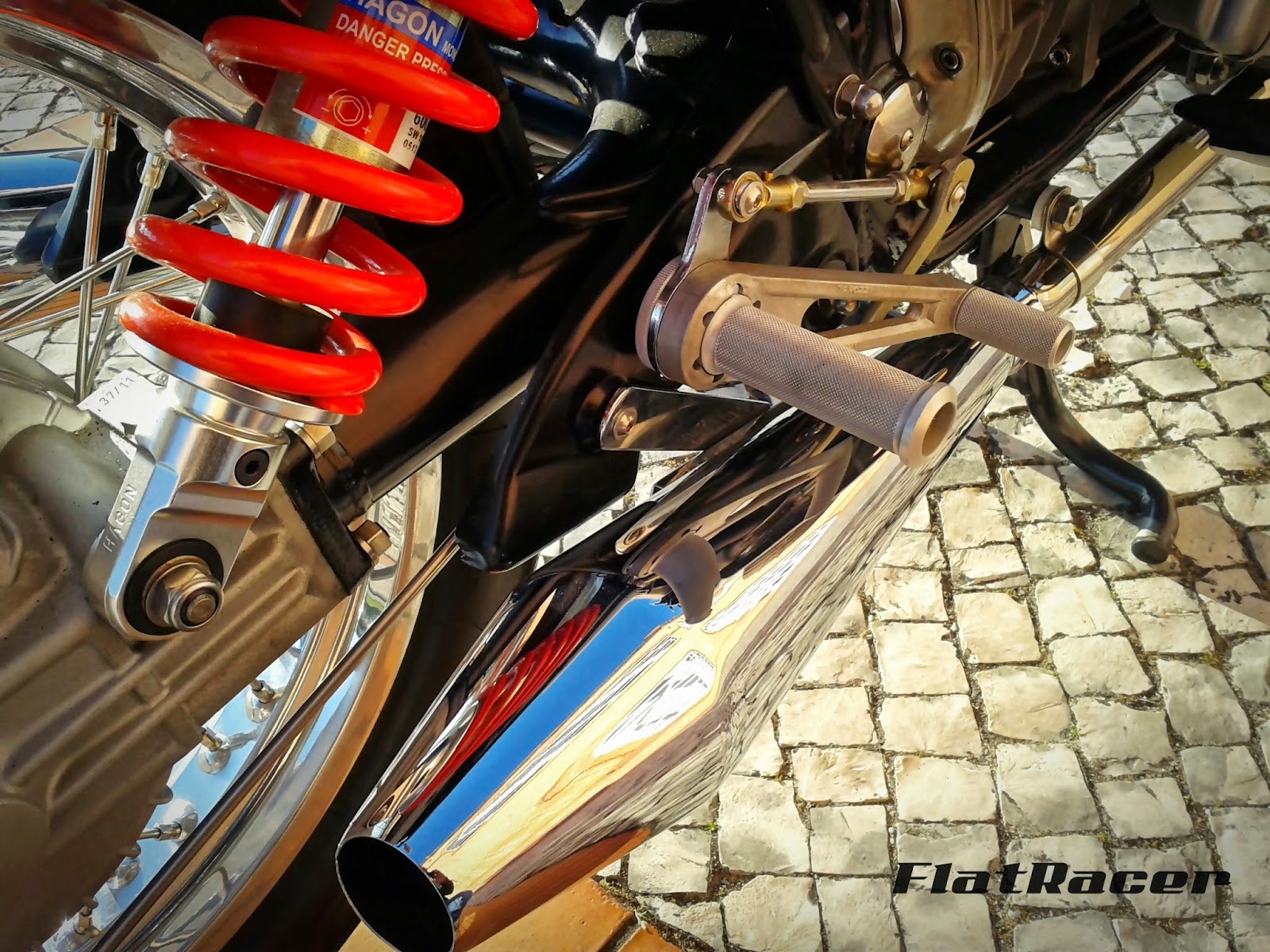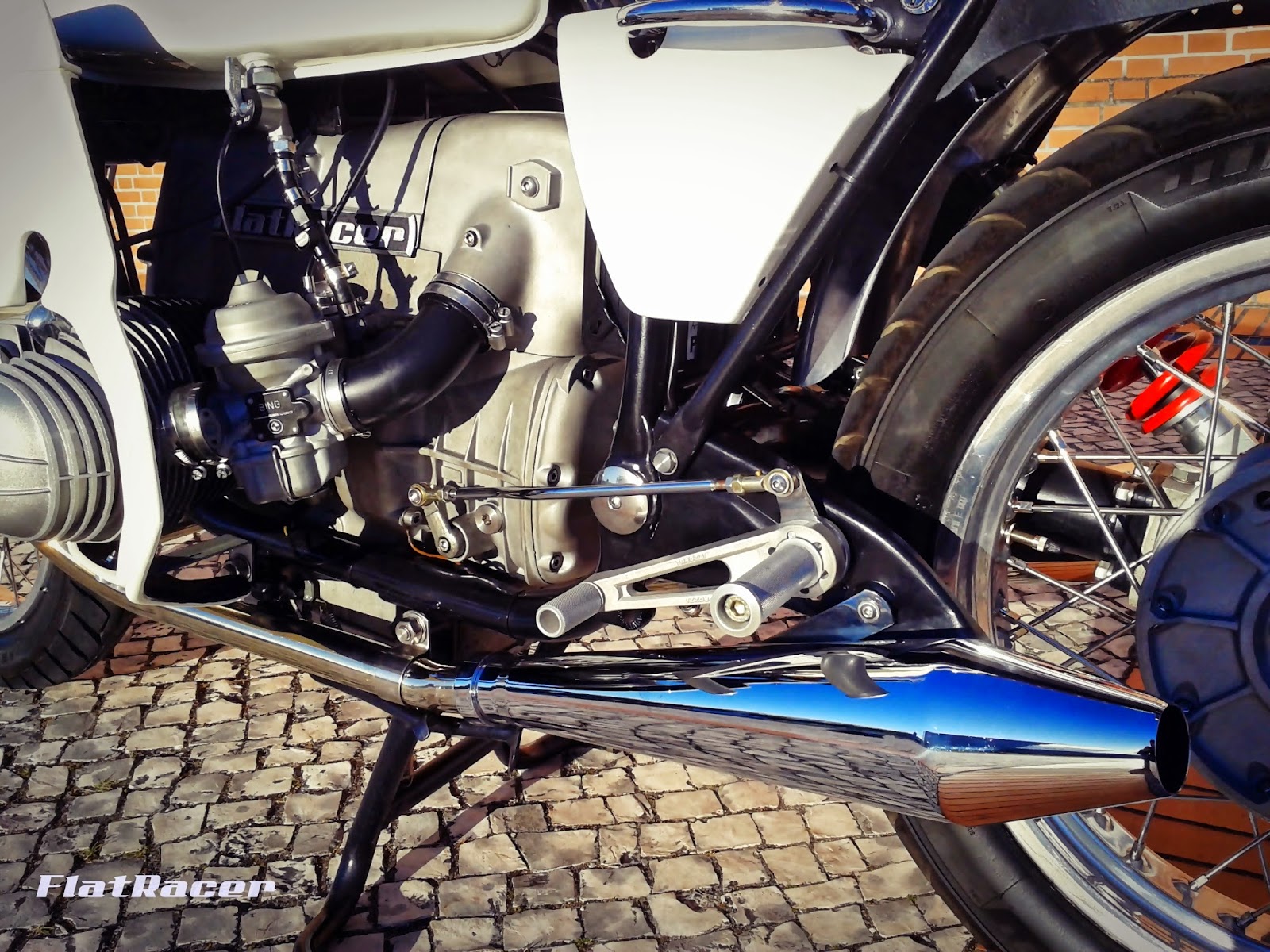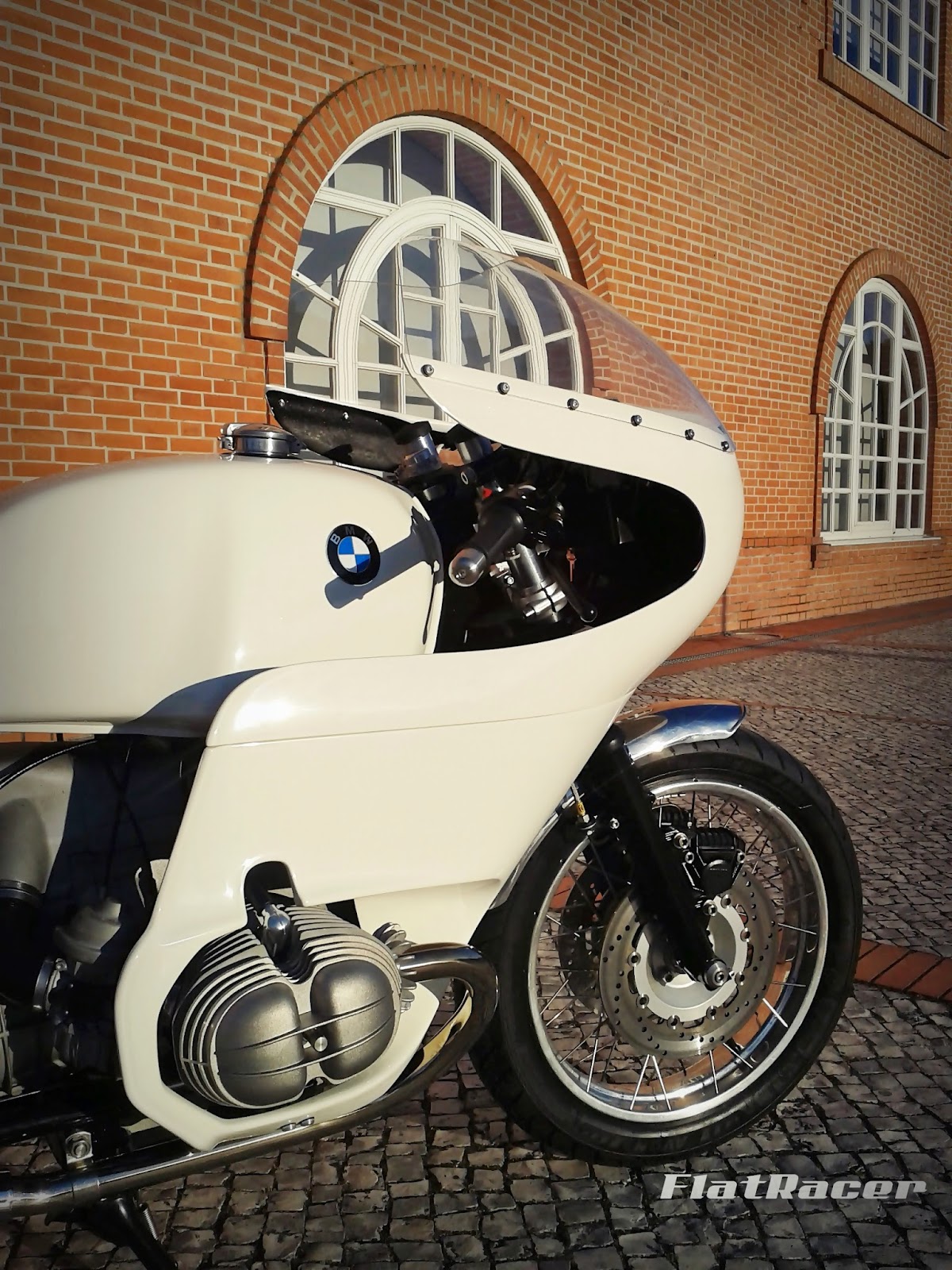FlatRacer Mancha Negra
BMW R2v Airehad custom motorcycle.
Built by FlatRacer (www.flatracer.com)
FlatRacer - BMW Cafe Racer
Welcome to FlatRacer, blog dedicated to all Cafe Racers, especially the BMW Cafe Racer, also known as Airheads or Boxers!
Wednesday 6 August 2014
Monday 21 July 2014
FlatRacer Mancha Branca BMW Cafe Racer
FlatRacer Mancha Branca
Our FlatRacer Mancha Branca BMW Cafe Racer started with a challenge from Clymer Manuals to produce a unique bodywork for their CCR project that was unfortunately shelved when Haynes took over.
This was the perfect opportunity for us to start our long ambition plan to develop a full fairing kit for the BMW R2v Series. We are great admirers of the original Cafe Racer look and British short circuit racers from the 60s but very seldom we see this kind of Cafe Racer transformation.
After nearly 5 years of slow development, it is here. The Flowliner full fairing offers superior aerodynamic advantages contributing for higher speeds, lower fuel consumption and enhanced rider's comfort..
To complement the look, we've developed a short tail kit (FlatRacer Daytona tail) so the bike's design would flow and the stance would be spot on.
As per our mission statement, the bike was to be modified without altering irreversibly its frame or other main ancillaries. Certainly a formidable task but we've allied our frame dictate with practicality by developing new stainless steel mudguards, fitted at the rear with our alloy L679 tail light.
Our Mancha Branca would serve as development mule for many other parts that we intend to incorporate in our catalogue of parts. These include our new FlatRacer Flowliner full fairing kit, FlatRacer/Tarozzi rear sets, FlatRacer 4.5" & 5.75" s/s mudguards, s/s battery tray kit, FlatRacer alloy triple clamp and many other parts for the Monolever and twin shock series.
As extra fun, we've decided to use parts from varied sources and models, confirming thus the interchangeability of components between different BMW R2v Airhead Series, from the 1969 /5 to the later 1995 Paralever, by using some ingenuity.
Our Mancha Branca features a 1990 BMW Monolever frame and a 1972 R60/5 engine bored to 800cc. The gearbox is post 81 (lighter flywheel), rear wheel from a GS mated to a 18" rim and the front wheel from a Paralever just to mention some of the most noticeable parts.
Click here for more info and pics:
http://www.flatracer.com/#/flatracer-bmw-mancha-branca/4585637366
Our FlatRacer Mancha Branca BMW Cafe Racer started with a challenge from Clymer Manuals to produce a unique bodywork for their CCR project that was unfortunately shelved when Haynes took over.
This was the perfect opportunity for us to start our long ambition plan to develop a full fairing kit for the BMW R2v Series. We are great admirers of the original Cafe Racer look and British short circuit racers from the 60s but very seldom we see this kind of Cafe Racer transformation.
After nearly 5 years of slow development, it is here. The Flowliner full fairing offers superior aerodynamic advantages contributing for higher speeds, lower fuel consumption and enhanced rider's comfort..
To complement the look, we've developed a short tail kit (FlatRacer Daytona tail) so the bike's design would flow and the stance would be spot on.
As per our mission statement, the bike was to be modified without altering irreversibly its frame or other main ancillaries. Certainly a formidable task but we've allied our frame dictate with practicality by developing new stainless steel mudguards, fitted at the rear with our alloy L679 tail light.
Our Mancha Branca would serve as development mule for many other parts that we intend to incorporate in our catalogue of parts. These include our new FlatRacer Flowliner full fairing kit, FlatRacer/Tarozzi rear sets, FlatRacer 4.5" & 5.75" s/s mudguards, s/s battery tray kit, FlatRacer alloy triple clamp and many other parts for the Monolever and twin shock series.
As extra fun, we've decided to use parts from varied sources and models, confirming thus the interchangeability of components between different BMW R2v Airhead Series, from the 1969 /5 to the later 1995 Paralever, by using some ingenuity.
Our Mancha Branca features a 1990 BMW Monolever frame and a 1972 R60/5 engine bored to 800cc. The gearbox is post 81 (lighter flywheel), rear wheel from a GS mated to a 18" rim and the front wheel from a Paralever just to mention some of the most noticeable parts.
Click here for more info and pics:
http://www.flatracer.com/#/flatracer-bmw-mancha-branca/4585637366
Sunday 29 June 2008
Cafe Racer Story

BMW R100 Cafe Racer
Cafe Racers started right here in UK, in the Fifties, where hardship form II World War was slowly evading, Rock & Roll appeared and social values started to change.
Motorcycles were still common daily transport, even for families, with a side car outfit then later the Microcars. More young people started to have the means to afford personal transportation, being an older bike or a younger scooter or perhaps a very old Austin Seven, good thing Mots' hadn't come into force yet!
From this time, we started to see young bikers congregating together at greasy, lay-by Cafes that populated our roadsides and a movement was born, bikes and Rock & Roll!
But old bikes was often what theses chaps and ladettes could afford, with new bikes still mostly out of reach so, how do we get an old bike to go faster? Exactly, remove all that is unnecessary, begin with the fat pillion!
In those days, any vehicle that could do 100mph was extraordinary, remember, the Jaguar XK120 born in 1948 was so called because it could attain 120mph, making it the fastest production automobile in the world! Later in Jabekke, it managed well over 140mph with a blueprinted engine and some aerodynamic mods such as bubble canopy.
Vincent Black Shadow was then the fastest production bike, with potential for over 125 mph (200Km/h) and could do 0-60mph in less than 6.5 secs! But its price when new was proportionate with its qualities - high!
So, the real challenge for these lads was to get their home brewed bikes to over 100mph (160km/h) with some more or less successful home tuned engines, sometimes resulting in some spectacular blow-up doing the ton-up!
Some Cafes became notorious and quite famous in their own right, with Ace Cafe in North West London by the North Circular, revived few years ago by Mark Willsmore hands, the Busy Bee in Watford Junction sadly no longer with us but revived now through a club and Johnson’s Cafe on A20 in West Kingsdon, East London, not far from Brands Hatch, where the lads got sometimes over excited and did some road racing on A20 on the way to the races!
One of my favourite stories is the one about putting a coin on the Ace's Jukebox and go for an impromptu road race on North Circular on a pre-set route, normally to Hanger Lane Junction (about 1 mile and a bit away) before it became the Gyratory System uniting A40, A406 and A4005 and see who would get back before the song ended!
No mean feat as usually these rock n' roll songs played for less than 3 minutes!
Thanks to these places, we had the Rockers with their Cafe Racers and the Mods with their Italian suits and Lambrettas with about a zillion mirrors!
In history was recorded their famous seaside battles such as Brighton and Hastings, but in their own words, it was just the media making a fuss out of it!
Quadrophenia movie was shot in 1979 (with Sting no less) portraying these British youth sub-cultures. You will notice the ever-present Rockers black leather jackets, goggles and pudding helmets! Just like Ogri!
If you enjoy movies, don’t miss the experimental Tunnel of Love, with guest appearance with Eddie Kid, a truly great short movie. Last time I saw it for sale was at Ace’s.
In the old days, a common way to build a Cafe Racer was to use a Norton featherbed frame, discarded by Formula Junior builders such as Cooper, as Norton would not supply its Manx 500 engine by itself and shove a Triumph engine to it.
Triton was born and with it came alloy tanks, alloy mudguards, rear sets, clip ons, racy seats, all in attempt to emulate the era's racing bikes. Other configurations were attempted including, Tribsa, Norvin, Norbsa and all kinds of "Bitsas". Some builders got famous such as Dresda, Rickman, Metisse, Norvil, Dunstall, Rob North etc, with their tailored kits and accessories.
Remember, at this time there were not speed limits on Motorways, that came later, courtesy of some Ford chaps, Jack Sears and Peter Bolton testing a Daytona Cobra on the M1 at over 185mph and some journalist with nothing better to write about on the Sunday Times newspaper. After all the fuss, 70mph limit was imposed in Britain, by Barbara Castle, Minister of Transport, in 1967. The 70mph is still with us today.
Nevertheless, the Metropolitan police thought that a ton up on North Circular was a no-no, therefore they acquired a secret weapon, oh yes! A fleet of gleaming, very fast Daimler Darts, with special training given to police drivers at Hendon.
These cars were equipped with a 2.5l OHC, all alloy V8 with hemi heads, capable of 125 mph, developed by Edward Turner, yes the same from Triumph fame, responsible for the Speed Twin. Ironic or what?
Eventually, the spirit died away, with Greasers coming on the scene by the end of Sixties. Rockers and Mods got married, jobs, families, a dog... leaving the Brighton and other seaside town battles well behind.
Actually, we are living a revival of the scene, with major manufacturers taking a keen interest in this type of bike with Triumph Bonneville/Thruxton, Ducati GT/Paul Smart, Moto Guzzi, Voxan, Benelli and even Royal Enfield not discounting the Japanese offerings although more in line Street Fighter trend.
Ace Cafe has re opened by Mark Willsmore and has thriving presence in all things motoring, becoming rapidly the mecca for PetrolHeads.
Nowadays, we still fallow the same process with all major British makes as a base for a Cafe Racer and there's a huge range of companies dedicated to the Cafe Racer movement but it is not exactly cheap to have something stylish and reliable unless you use some ingenuity and do most of the work by yourself!
Motorcycles were still common daily transport, even for families, with a side car outfit then later the Microcars. More young people started to have the means to afford personal transportation, being an older bike or a younger scooter or perhaps a very old Austin Seven, good thing Mots' hadn't come into force yet!
From this time, we started to see young bikers congregating together at greasy, lay-by Cafes that populated our roadsides and a movement was born, bikes and Rock & Roll!
But old bikes was often what theses chaps and ladettes could afford, with new bikes still mostly out of reach so, how do we get an old bike to go faster? Exactly, remove all that is unnecessary, begin with the fat pillion!
In those days, any vehicle that could do 100mph was extraordinary, remember, the Jaguar XK120 born in 1948 was so called because it could attain 120mph, making it the fastest production automobile in the world! Later in Jabekke, it managed well over 140mph with a blueprinted engine and some aerodynamic mods such as bubble canopy.
Vincent Black Shadow was then the fastest production bike, with potential for over 125 mph (200Km/h) and could do 0-60mph in less than 6.5 secs! But its price when new was proportionate with its qualities - high!
So, the real challenge for these lads was to get their home brewed bikes to over 100mph (160km/h) with some more or less successful home tuned engines, sometimes resulting in some spectacular blow-up doing the ton-up!
Some Cafes became notorious and quite famous in their own right, with Ace Cafe in North West London by the North Circular, revived few years ago by Mark Willsmore hands, the Busy Bee in Watford Junction sadly no longer with us but revived now through a club and Johnson’s Cafe on A20 in West Kingsdon, East London, not far from Brands Hatch, where the lads got sometimes over excited and did some road racing on A20 on the way to the races!
One of my favourite stories is the one about putting a coin on the Ace's Jukebox and go for an impromptu road race on North Circular on a pre-set route, normally to Hanger Lane Junction (about 1 mile and a bit away) before it became the Gyratory System uniting A40, A406 and A4005 and see who would get back before the song ended!
No mean feat as usually these rock n' roll songs played for less than 3 minutes!
Thanks to these places, we had the Rockers with their Cafe Racers and the Mods with their Italian suits and Lambrettas with about a zillion mirrors!
In history was recorded their famous seaside battles such as Brighton and Hastings, but in their own words, it was just the media making a fuss out of it!
Quadrophenia movie was shot in 1979 (with Sting no less) portraying these British youth sub-cultures. You will notice the ever-present Rockers black leather jackets, goggles and pudding helmets! Just like Ogri!
If you enjoy movies, don’t miss the experimental Tunnel of Love, with guest appearance with Eddie Kid, a truly great short movie. Last time I saw it for sale was at Ace’s.
In the old days, a common way to build a Cafe Racer was to use a Norton featherbed frame, discarded by Formula Junior builders such as Cooper, as Norton would not supply its Manx 500 engine by itself and shove a Triumph engine to it.
Triton was born and with it came alloy tanks, alloy mudguards, rear sets, clip ons, racy seats, all in attempt to emulate the era's racing bikes. Other configurations were attempted including, Tribsa, Norvin, Norbsa and all kinds of "Bitsas". Some builders got famous such as Dresda, Rickman, Metisse, Norvil, Dunstall, Rob North etc, with their tailored kits and accessories.
Remember, at this time there were not speed limits on Motorways, that came later, courtesy of some Ford chaps, Jack Sears and Peter Bolton testing a Daytona Cobra on the M1 at over 185mph and some journalist with nothing better to write about on the Sunday Times newspaper. After all the fuss, 70mph limit was imposed in Britain, by Barbara Castle, Minister of Transport, in 1967. The 70mph is still with us today.
Nevertheless, the Metropolitan police thought that a ton up on North Circular was a no-no, therefore they acquired a secret weapon, oh yes! A fleet of gleaming, very fast Daimler Darts, with special training given to police drivers at Hendon.
These cars were equipped with a 2.5l OHC, all alloy V8 with hemi heads, capable of 125 mph, developed by Edward Turner, yes the same from Triumph fame, responsible for the Speed Twin. Ironic or what?
Eventually, the spirit died away, with Greasers coming on the scene by the end of Sixties. Rockers and Mods got married, jobs, families, a dog... leaving the Brighton and other seaside town battles well behind.
Actually, we are living a revival of the scene, with major manufacturers taking a keen interest in this type of bike with Triumph Bonneville/Thruxton, Ducati GT/Paul Smart, Moto Guzzi, Voxan, Benelli and even Royal Enfield not discounting the Japanese offerings although more in line Street Fighter trend.
Ace Cafe has re opened by Mark Willsmore and has thriving presence in all things motoring, becoming rapidly the mecca for PetrolHeads.
Nowadays, we still fallow the same process with all major British makes as a base for a Cafe Racer and there's a huge range of companies dedicated to the Cafe Racer movement but it is not exactly cheap to have something stylish and reliable unless you use some ingenuity and do most of the work by yourself!
BMW Cafe Racer

Cafe Racers started right here in UK, in the Fifties, where hardships form II World War was slowly evaporating, Rock & Roll appeared and social values started to change.
Welcome to FlatRacer, dedicated to the Cafe Racers, especially the BMW Cafe Racer!
We live now in the age of more affluence and less time, where nobody wants to be another brick on the wall. Cafe Racers are still very much perceived as a very individual affirmation of one's personality.
In this world filled with ultra fast, ultra plastic-fantastic bikes, that every Harry & Dick and their dog have one, fortunately some people want to strike a difference!
Enter the BMW Airhead R series 2 valve, produced in tenths of thousands, for over 24 years, incredibly reliable, oil tight, well equipped, good handling and quite fast on 800, 900 and 1000cc configurations.
Because there are so many survivors, these bikes tend to be underrated and under priced, but with a loyal legion of cognoscenti giving it its true value.
Unbelievably, a lot of these bikes are still used everyday, even for commuting!
Parts are plentiful and there's also a dedicated range of specialists producing go faster items such as WBT, Knoscher, Disrael and SiebenRock.
Very few BMW Cafe Racers really appealed to me aesthetically, with quite a few shortcomings in design, from the builders’ compromise in using parts not really designed for the BMW frame. It kick started my desire to do something different and hopefully, better!
I then decided to design and develop a Cafe Racer kit for these underrated bikes, picking up three bikes in the process, which you will find in my site, being The Shed, The Blaxer and The Copper.
I started by the tank, underneath based on a Monolever Boxer so it would fit all Airheads, with a design loosely based on a Manx Sprint three gallon tank, with indents for the knees and clip ons.
The top fairing was based on a Ducati bevel (750/900SS) with a headlight opening from a R90S cockpit fairing,
The tail is based on a Knoscher design, used by BMW AMA racers in the Seventies with a bolt on padded seat for those wishing more comfort. Front mudguard is based on an original BMW but shortened by 24 cm, keeping the bead edge all around.
Fuel cap is a 57mm Monza, fitted as an aftermarket bit on old Minis.
Side panels are replicas of original BMW items.
Clip ons, silencers and rear sets are from Raask in Sweden but any clip on with fork dimension will do, best are from Tomaselli, rear sets can be Tarozzi albeit linkages need to be produced for it, silencers can be Norton PeaShooters or any other as brackets need to be produced
So if the idea of a different Cafe Racer appeals to you, please, don't hesitate to contact me, be it for bikes, parts, ideas or suggestions!
I will try to develop new ideas and parts in the near future, depending on demand, so please keep an eye in my site www.flatracer.com or contact me.
Welcome to FlatRacer, dedicated to the Cafe Racers, especially the BMW Cafe Racer!
We live now in the age of more affluence and less time, where nobody wants to be another brick on the wall. Cafe Racers are still very much perceived as a very individual affirmation of one's personality.
In this world filled with ultra fast, ultra plastic-fantastic bikes, that every Harry & Dick and their dog have one, fortunately some people want to strike a difference!
Enter the BMW Airhead R series 2 valve, produced in tenths of thousands, for over 24 years, incredibly reliable, oil tight, well equipped, good handling and quite fast on 800, 900 and 1000cc configurations.
Because there are so many survivors, these bikes tend to be underrated and under priced, but with a loyal legion of cognoscenti giving it its true value.
Unbelievably, a lot of these bikes are still used everyday, even for commuting!
Parts are plentiful and there's also a dedicated range of specialists producing go faster items such as WBT, Knoscher, Disrael and SiebenRock.
Very few BMW Cafe Racers really appealed to me aesthetically, with quite a few shortcomings in design, from the builders’ compromise in using parts not really designed for the BMW frame. It kick started my desire to do something different and hopefully, better!
I then decided to design and develop a Cafe Racer kit for these underrated bikes, picking up three bikes in the process, which you will find in my site, being The Shed, The Blaxer and The Copper.
I started by the tank, underneath based on a Monolever Boxer so it would fit all Airheads, with a design loosely based on a Manx Sprint three gallon tank, with indents for the knees and clip ons.
The top fairing was based on a Ducati bevel (750/900SS) with a headlight opening from a R90S cockpit fairing,
The tail is based on a Knoscher design, used by BMW AMA racers in the Seventies with a bolt on padded seat for those wishing more comfort. Front mudguard is based on an original BMW but shortened by 24 cm, keeping the bead edge all around.
Fuel cap is a 57mm Monza, fitted as an aftermarket bit on old Minis.
Side panels are replicas of original BMW items.
Clip ons, silencers and rear sets are from Raask in Sweden but any clip on with fork dimension will do, best are from Tomaselli, rear sets can be Tarozzi albeit linkages need to be produced for it, silencers can be Norton PeaShooters or any other as brackets need to be produced
So if the idea of a different Cafe Racer appeals to you, please, don't hesitate to contact me, be it for bikes, parts, ideas or suggestions!
I will try to develop new ideas and parts in the near future, depending on demand, so please keep an eye in my site www.flatracer.com or contact me.
Ride on!
Subscribe to:
Posts (Atom)




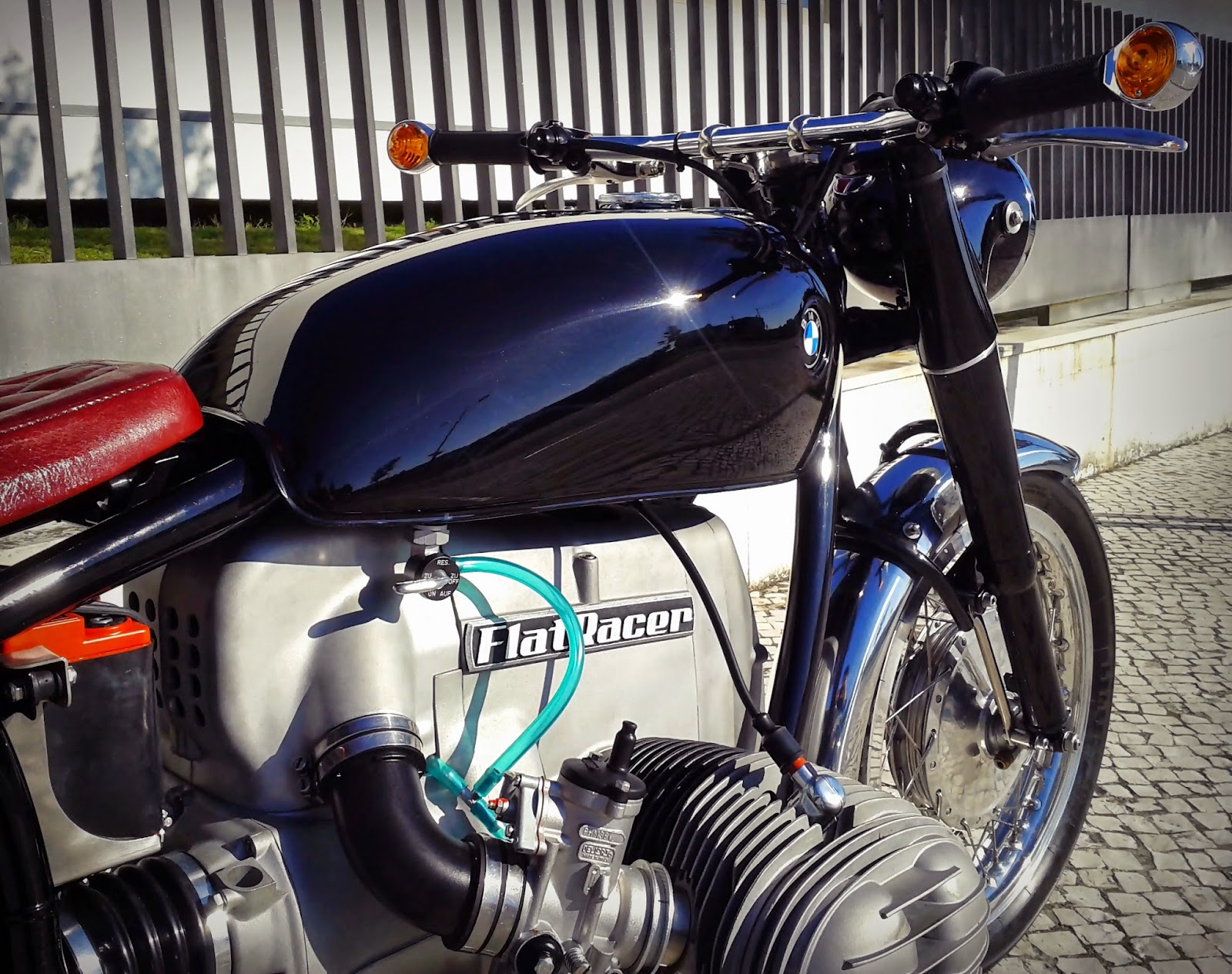

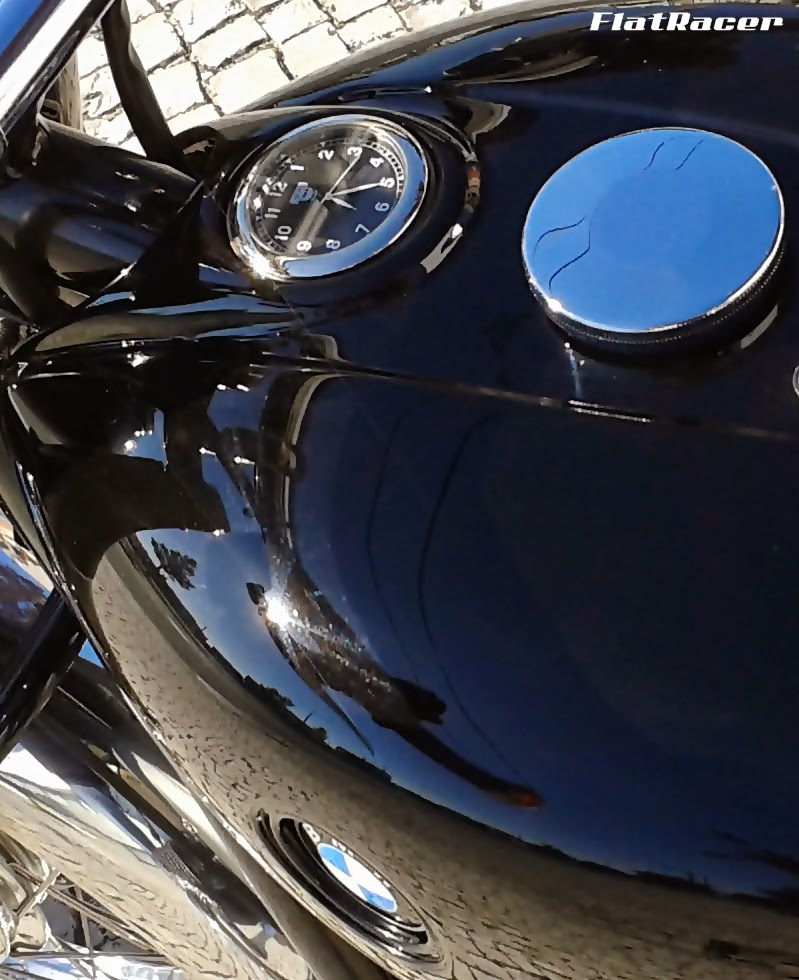






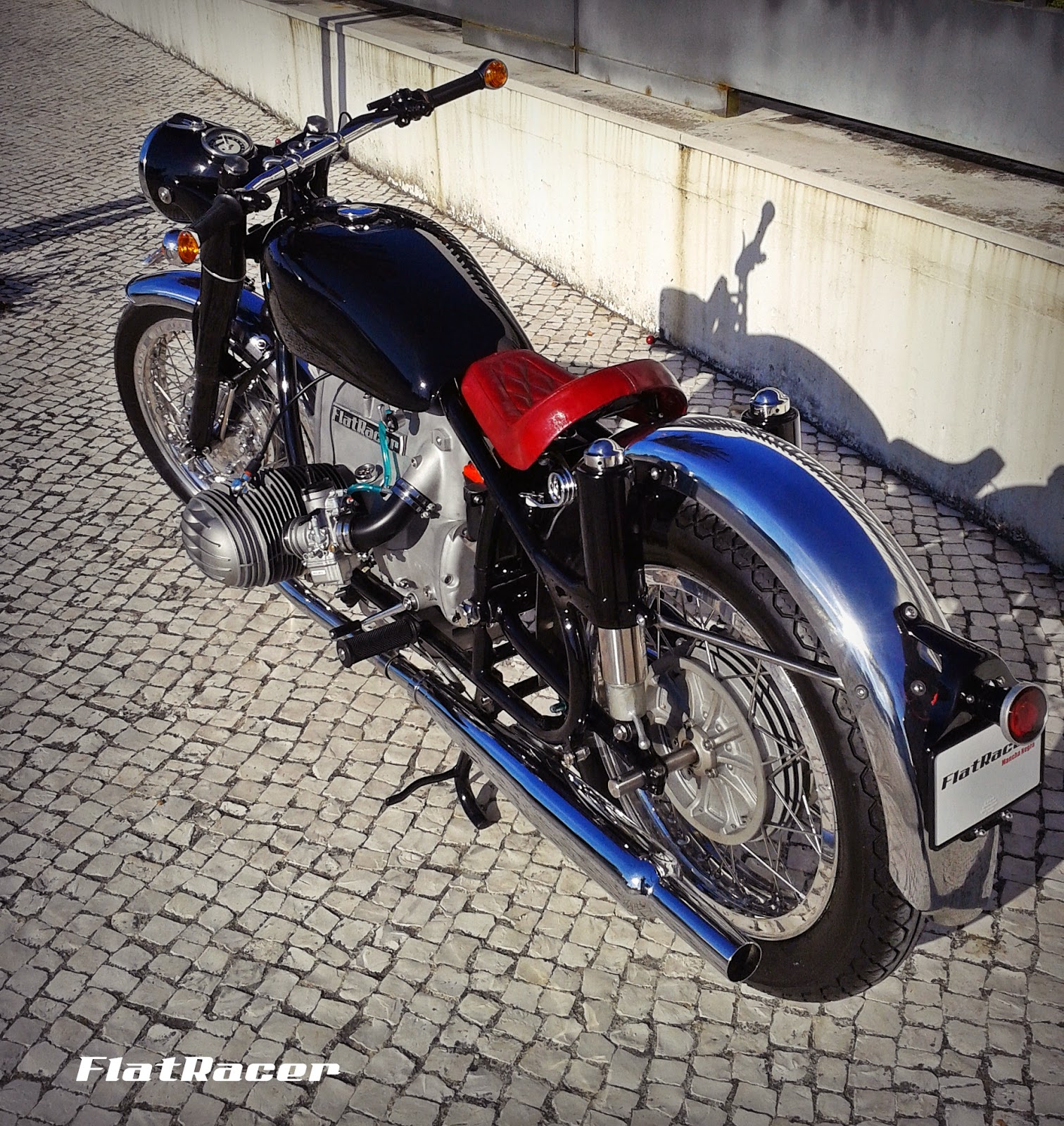
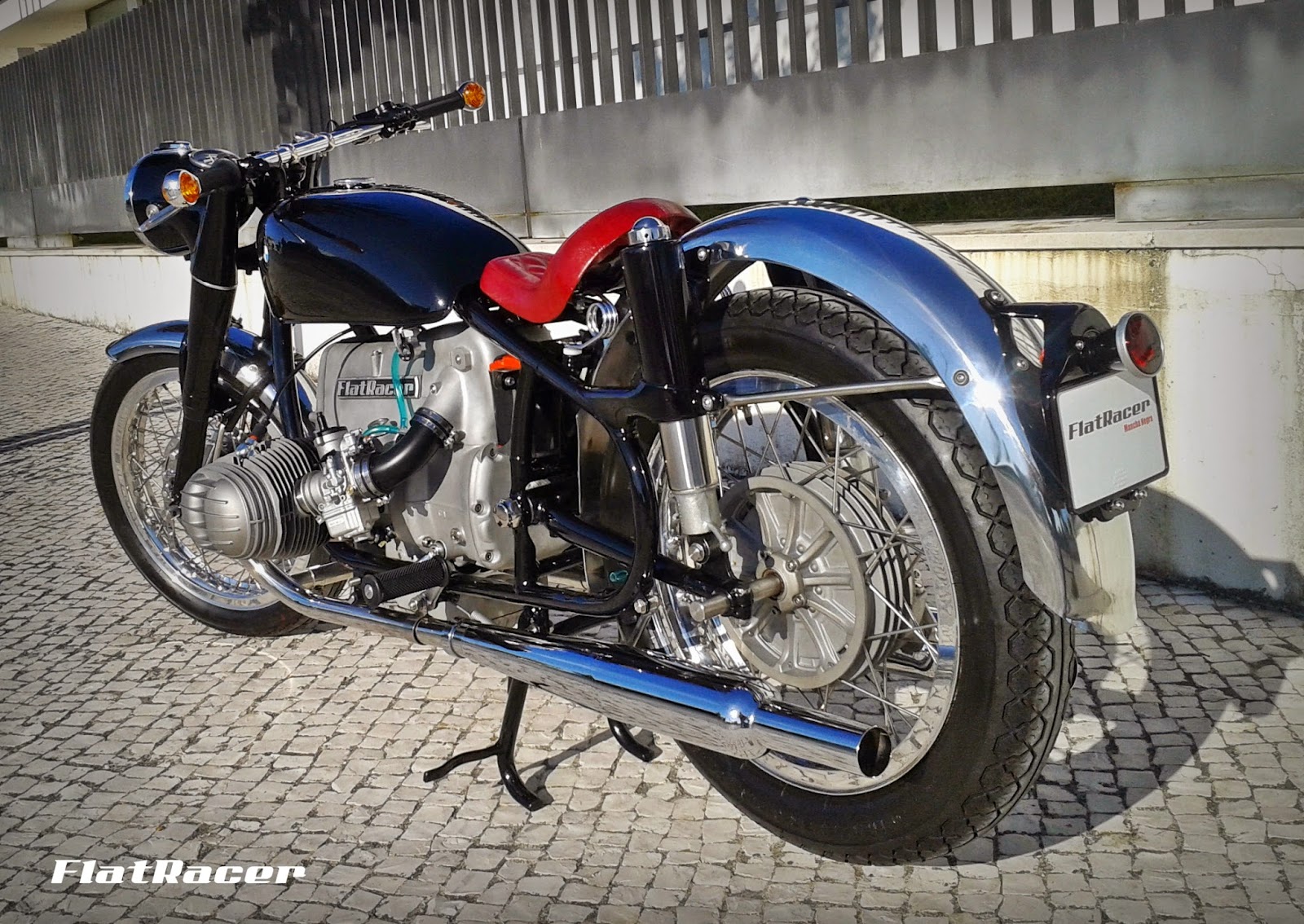

.jpg)

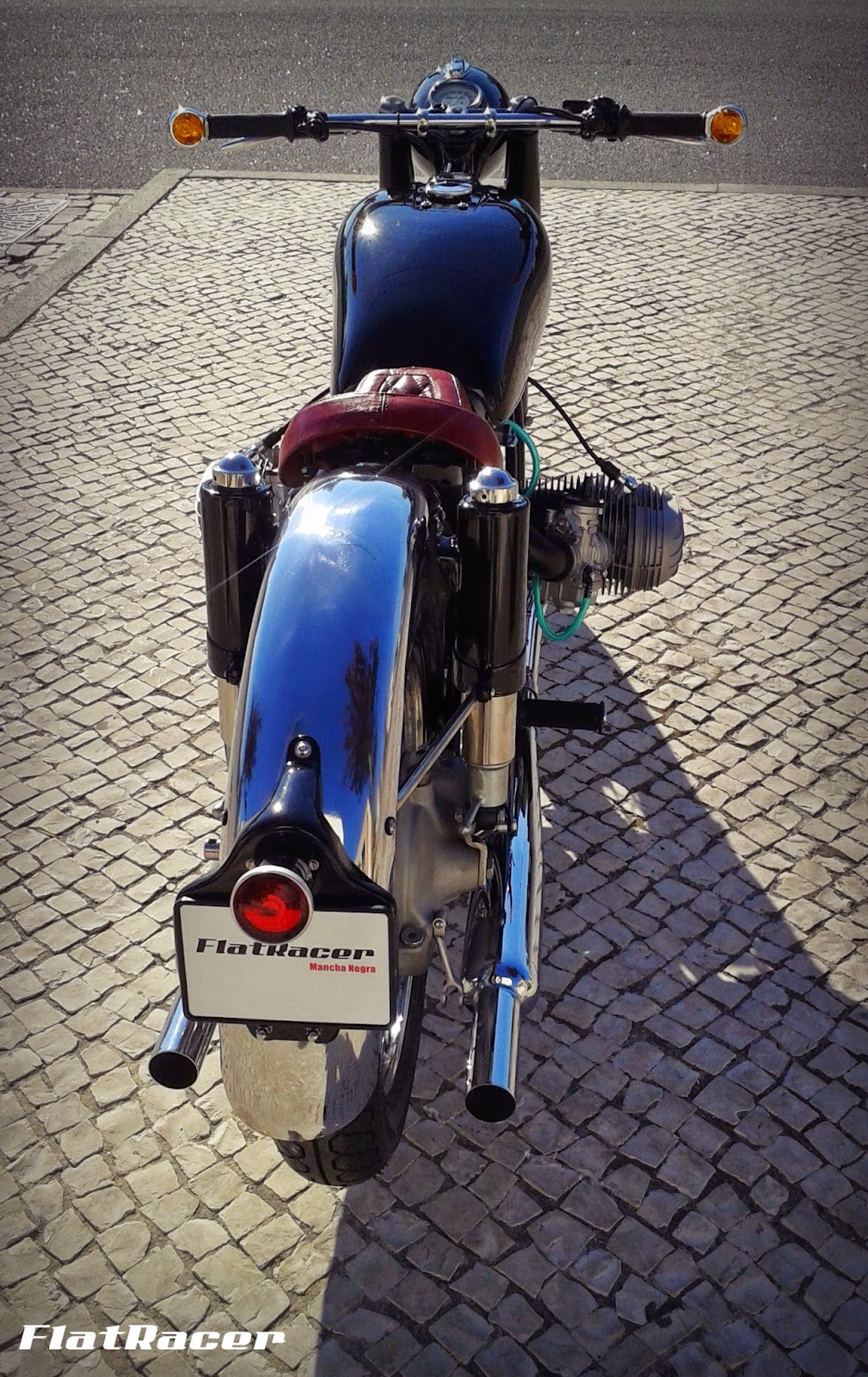
.jpg)


.jpg)

.jpg)
